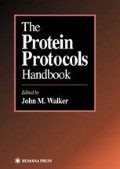Abstract
Sodium dodecyl sulfate-polyacrylamide gel electrophoresis (SDS-PAGE) has proven to be among the most useful tools yet developed in the area of molecular biology. The discontinuous buffer system, first described by Laemmli (1), has made it possible to separate, visualize, and compare readily the component parts of complex mixtures of molecules (e.g., tissues, cells). SDS-PAGE separation of proteins and peptides makes it possible to quantify the amount of a particular protein/peptide in a sample, obtain fairly reliable molecular mass information, and, by combining SDS-PAGE with immunoelectroblotting, evaluate the antigenicity of proteins and peptides. SDS-PAGE is both a powerful separation system and a reliable preparative purification technique (2 and see Chapter 11).
Access this chapter
Tax calculation will be finalised at checkout
Purchases are for personal use only
References
Laemmli, U. K. (1970) Cleavage of structural proteins during the assembly of the head of bacteriophage T4. Nature 227, 680–695.
Judd, R. C. (1988) Purification of outer membrane proteins of the Gram negative bacterium Neisseria gonorrhoeae. Anal. Biochem. 173, 307–316.
Dreyfuss, G., Adam, S. A., and Choi, Y. D. (1984) Physical change in cytoplasmic messenger ribonucleoproteins in cells treated with inhibitors of mRNA transcription. Mol. Cell. Biol. 4, 415–423.
Schagger, H. and von Jagow, G. (1987) Tricine-sodium dodecyl sulfate-polyacrylamide gel electrophoresis for the separation of proteins in the range from 1 to 100 kDa. Anal. Biochem. 166, 368–397.
Judd, R. C. (1986) Evidence for N-terminal exposure of the PIA subclass of protein I of Neisseria gonorrhoeae. Infect. Immunol. 54, 408–414.
Moos, M., Jr. and Nguyen, N. Y. (1988) Reproducible high-yield sequencing of proteins electrophoretically separated and transferred to an inert support. J. Biol. Chem. 263, 6005–6008.
Stoll, V. S. and Blanchard, J. S. (1990) Buffers: principles and practice, in Methods in Enzymology, vol. 182, A Guide to Protein Purification (Deutscher, M. P., ed.), Academic, San Diego, CA, pp. 24–38.
Author information
Authors and Affiliations
Editor information
Editors and Affiliations
Rights and permissions
Copyright information
© 1996 Humana Press Inc., Totowa, NJ
About this protocol
Cite this protocol
Judd, R.C. (1996). SDS-Polyacrylamide Gel Electrophoresis of Peptides. In: Walker, J.M. (eds) The Protein Protocols Handbook. Springer Protocols Handbooks. Humana Press. https://doi.org/10.1007/978-1-60327-259-9_16
Download citation
DOI: https://doi.org/10.1007/978-1-60327-259-9_16
Publisher Name: Humana Press
Print ISBN: 978-0-89603-338-2
Online ISBN: 978-1-60327-259-9
eBook Packages: Springer Book Archive

